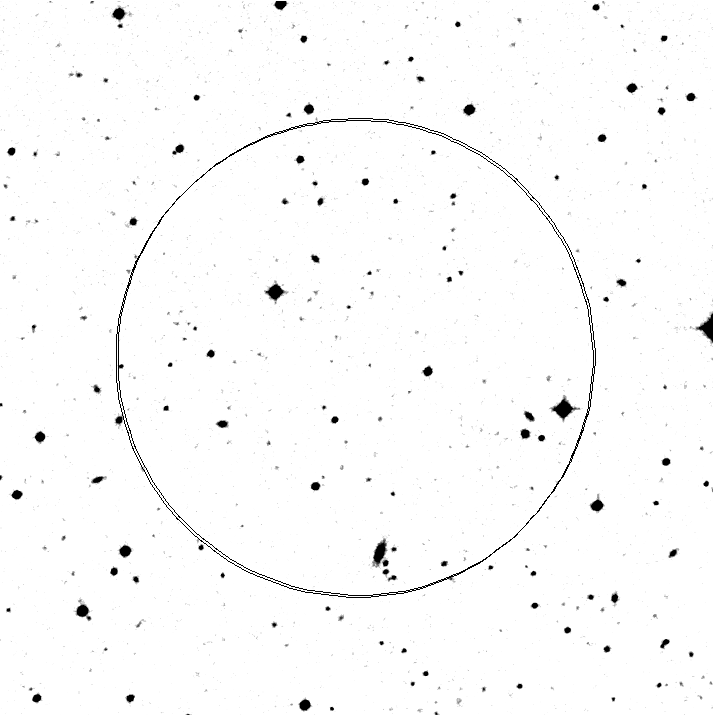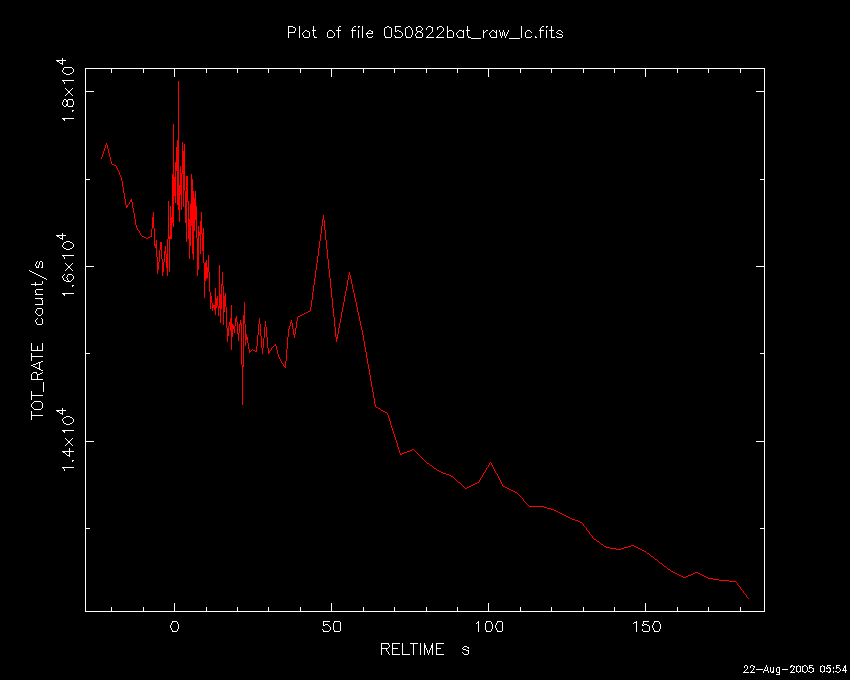- GCN/BACODINE POSITION NOTICE
TITLE: GCN/SWIFT NOTICE
NOTICE_DATE: Mon 22 Aug 05 03:49:55 UT
NOTICE_TYPE: Swift-BAT GRB Position
TRIGGER_NUM: 151486, Seg_Num: 0
GRB_RA: 51.080d {+03h 24m 19s} (J2000),
51.127d {+03h 24m 31s} (current),
50.664d {+03h 22m 39s} (1950)
GRB_DEC: -46.023d {-46d 01' 22"} (J2000),
-46.003d {-46d 00' 11"} (current),
-46.199d {-46d 11' 55"} (1950)
GRB_ERROR: 4.00 [arcmin radius, statistical only]
GRB_INTEN: 15863 [cnts] Image_Peak=425 [image_cnts]
TRIGGER_DUR: 2.048 [sec]
TRIGGER_INDEX: 257 E_range: 15-50 keV
BKG_INTEN: 184534 [cnts]
BKG_TIME: 13736.00 SOD {03:48:56.00} UT
BKG_DUR: 24 [sec]
GRB_DATE: 13604 TJD; 234 DOY; 05/08/22
GRB_TIME: 13769.14 SOD {03:49:29.14} UT
GRB_PHI: 165.56 [deg]
GRB_THETA: 41.94 [deg]
SOLN_STATUS: 0x3
RATE_SIGNIF: 7.41 [sigma]
IMAGE_SIGNIF: 9.73 [sigma]
MERIT_PARAMS: +1 +0 +0 +1 +1 +0 +0 +0 +26 +1
SUN_POSTN: 151.29d {+10h 05m 10s} +11.76d {+11d 45' 50"}
SUN_DIST: 105.47 [deg]
MOON_POSTN: 2.96d {+00h 11m 52s} +0.07d {+00d 04' 07"}
MOON_DIST: 62.45 [deg]
MOON_ILLUM: 92 [%]
GAL_COORDS: 255.29,-54.45 [deg] galactic lon,lat of the burst (or transient)
ECL_COORDS: 25.64,-61.06 [deg] ecliptic lon,lat of the burst (or transient)
COMMENTS: SWIFT-BAT GRB Coordinates.
COMMENTS: This is a rate trigger.
COMMENTS: A point_source was found.
COMMENTS: This does not match any source in the on-board catalog.
COMMENTS: This does not match any source in the ground catalog.
COMMENTS: This is a GRB.
- red DSS finding chart
ps-file

- GCN/SWIFT NOTICE
TITLE: GCN/SWIFT NOTICE
NOTICE_DATE: Mon 22 Aug 05 03:51:42 UT
NOTICE_TYPE: Swift-XRT Position
TRIGGER_NUM: 151486, Seg_Num: 0
GRB_RA: 51.1113d {+03h 24m 26.7s} (J2000),
51.1582d {+03h 24m 37.9s} (current),
50.6955d {+03h 22m 46.9s} (1950)
GRB_DEC: -46.0329d {-46d 01' 58.4"} (J2000),
-46.0132d {-46d 00' 47.5"} (current),
-46.2085d {-46d 12' 30.4"} (1950)
GRB_ERROR: 5.8 [arcsec radius, statistical plus systematic, 90% containment]
GRB_INTEN: 1368.40 [arb]
GRB_SIGNIF: 11.13 [sigma]
GRB_DATE: 13604 TJD; 234 DOY; 05/08/22
GRB_TIME: 13864.86 SOD {03:51:04.86} UT [Start of CCD integration]
TAM[0-3]: 327.61 237.21 261.34 242.83
AMPLIFIER: 2
WAVEFORM: 134
SUN_POSTN: 151.29d {+10h 05m 10s} +11.76d {+11d 45' 48"}
SUN_DIST: 105.44 [deg]
MOON_POSTN: 2.98d {+00h 11m 55s} +0.08d {+00d 04' 35"}
MOON_DIST: 62.48 [deg]
MOON_ILLUM: 92 [%]
GAL_COORDS: 255.29,-54.43 [deg] galactic lon,lat of the burst
ECL_COORDS: 25.67,-61.08 [deg] ecliptic lon,lat of the burst
COMMENTS: SWIFT-XRT Coordinates.
COMMENTS: WARNING: XRT alignment calibration is on-going, and there may be
COMMENTS: residual systematic offsets of several arcseconds not accounted for yet
COMMENTS: by our on-board position determination algorithm. We have increased
COMMENTS: the estimated error circle radius to take this into account.
- GCN/SWIFT NOTICE
TITLE: GCN/SWIFT NOTICE
NOTICE_DATE: Mon 22 Aug 05 03:53:05 UT
NOTICE_TYPE: Swift-BAT GRB Lightcurve
TRIGGER_NUM: 151486, Seg_Num: 0
GRB_RA: 51.080d {+03h 24m 19s} (J2000),
51.127d {+03h 24m 31s} (current),
50.664d {+03h 22m 39s} (1950)
GRB_DEC: -46.023d {-46d 01' 22"} (J2000),
-46.003d {-46d 00' 11"} (current),
-46.199d {-46d 11' 55"} (1950)
GRB_DATE: 13604 TJD; 234 DOY; 05/08/22
GRB_TIME: 13769.14 SOD {03:49:29.14} UT
TRIGGER_INDEX: 257
GRB_PHI: 165.56 [deg]
GRB_THETA: 41.94 [deg]
DELTA_TIME: 77.00 [sec]
TRIGGER_DUR: 2.048 [sec]
LC_URL: sw00151486000msb.lc
SUN_POSTN: 151.29d {+10h 05m 10s} +11.76d {+11d 45' 50"}
SUN_DIST: 105.47 [deg]
MOON_POSTN: 2.96d {+00h 11m 52s} +0.07d {+00d 04' 07"}
MOON_DIST: 62.45 [deg]
MOON_ILLUM: 92 [%]
GAL_COORDS: 255.29,-54.45 [deg] galactic lon,lat of the pointing direction
ECL_COORDS: 25.64,-61.06 [deg] ecliptic lon,lat of the pointing direction
COMMENTS: SWIFT-BAT GRB Lightcurve.
COMMENTS:
COMMENTS: The next comments were copied from the BAT_POS Notice:
COMMENTS: This is a rate trigger.
COMMENTS: A point_source was found.
COMMENTS: This does not match any source in the on-board catalog.
COMMENTS: This does not match any source in the ground catalog.
COMMENTS: This is a GRB.

- GCN notice #3849
A. Blustin (UCL-MSSL), S. Barthelmy (GSFC), D. Burrows (PSU), M. Chester (PSU),
J. Cummings (GSFC/NRC), N. Gehrels (GSFC), J. Kennea (PSU), F. Marshall (GSFC),
D. Palmer (LANL), T. Sakamoto (GSFC)
on behalf of the Swift team:
At 03:49:29 UT, Swift-BAT triggered and located GRB050822 (trigger=151486).
The BAT on-board calculated location is RA,Dec 51.080d,-46.023d
{03h 24m 19s,-46d 01' 22"} (J2000), with an uncertainty of 2 arcmin
(radius, 90% containment, stat+sys). The BAT light curve shows two peaks
(at T+5 sec and T+50 sec) with a total duration of 70 sec. The peak count rate
was ~1500 counts/sec (15-350 keV), at ~5 sec after the trigger.
The spacecraft slewed promptly and the XRT began observing the GRB
at 03:51:05 UT (96 sec after the BAT trigger). A bright source was found
by the on-board centroiding algorithm at RA=03h 24m 26.7s, Dec=-46d 01' 58"
(J2000), with an estimated uncertainty of 8 arcsec (90% containment radius).
This is 86 arcsec from the BAT position. The count rate decreases during
the first 100 sec, although the fact that Swift was exiting from the SAA
could contribute to this.
The UVOT began observing the field of GRB050822 at 03:51:47, 138 sec
after the BAT trigger. No new source with respect to the DSS image is
detected at the XRT position in a 100 s V-band exposure down to a 3-sigma
upper limit of 18.4 mag.
- GCN notice #3850
E.S. Rykoff (U Mich) reports on behalf of the ROTSE collaboration:
ROTSE-IIIc, located at the H.E.S.S. site at Mt. Gamsberg, Namibia,
responded to GRB 050822 (Swift trigger 151486), producing images
beginning 5.8 s after the GCN notice time. An automated response took
the first image at 03:50:00.8 UT, 31.7 s after the start of the burst,
and during the gamma-ray emission (GCN 3849). These observations were
affected by proximity to the full moon as well as early twilight. We
took 10 5-sec, and 70 20-sec eposures. These unfiltered images are
calibrated relative to USNO A2.0 (R).
Comparison to the DSS (second epoch) reveals no new sources within the
3-sigma BAT error circle or at the XRT position, for both single images
and coadding into sets of 10. Individual images have limiting magnitudes
ranging from 15.0-16.2; we set the following specific limits.
start UT end UT t_exp(s) mlim t_start-tGRB(s) Coadd?
--------------------------------------------------------------------
03:50:00.8 3:50:05.8 5 15.1 31.7 N
03:50:00.8 3:51:24.8 84 16.6 31.7 Y
03:51:25.5 3:56:12.0 286 17.5 412.6 Y
- GCN notice #3856
D. Hullinger (UMD), L. Angelini (GSFC-JHU), L. Barbier (GSFC),
S. Barthelmy (GSFC), M. Chester (PSU), J. Cummings (GSFC/NRC),
E. Fenimore (LANL), N. Gehrels (GSFC), H. Krimm (GSFC/USRA),
C. Markwardt (GSFC/UMD), D. Palmer (LANL), A. Parsons (GSFC),
T. Sakamoto (GSFC/NRC), G. Sato (ISAS), J. Tueller (GSFC),
on behalf of the Swift-BAT team:
Using the full data set from the recent telemetry downlink, we report
further analysis of Swift-BAT GRB 050822 (trigger #151486)
(Blustin, et al., GCN 3849). The refined BAT ground position
is (RA,Dec) = 51.098, -46.031 {03:24:19.2, -46:01:22.8} [deg; J2000]
+-2 arcmin, (90% containment). This is 27 arc-seconds from the
XRT position reported in GCN 3849. The partial coding was 44%.
The light curve has two main peaks. The first peak starts from
T0-4 sec, peaking at T0, and then ending at T0+20 sec with a gradual
decay. The second peak contains multiple sub-peaks. It starts
from T0+20 sec and ends at T0+75 sec. There is a smaller, somewhat
softer peak from T+100 to T+104 seconds while Swift was pointing at
the source and the XRT was taking data. T90 (15-350 keV) is (102 +- 2)
seconds (estimated error including systematics).
The power law index of the time-averaged spectrum is 2.5 +- 0.1.
Thus, the time-averaged spectrum turns out to be soft.
The fluence in the 15-350 keV band is (3.4 +- 0.3) x 10^-6 erg/cm2.
The 1-s peak photon flux measured from T0+47.6 second in the 15-350 keV
band is (2.9 +- 0.3) ph/cm2/s. All the quoted errors are at the 90%
confidence level.
- GCN notice #3859
M. J. Page, H. Ziaeepour, A. J. Blustin (UCL-MSSL), M. Chester (PSU),
R. Fink (GSFC), N. Gehrels (GSFC) on behalf of the Swift UVOT team
The Swift/UVOT began observing the field of GRB050822 at 03:51:47,
138 s after the BAT trigger (Blustin et al., GCN 3849). No new source
(with respect to the DSS image) is observed at the XRT position in
summed images from any of the six filters down to the following
3-sigma magnitude upper limits:
Filter T_range (s) Exp (s) 3-sig UL (mag)
V 138-1090 278 19.5
B 284-1453 135 19.7
U 270-1402 188 19.4
UVW1 257-1298 188 20.0
UVM2 242-1194 188 20.6
UVW2 300-986 88 20.0
Where T_range is the time range post-trigger over which images were
co-added.
The magnitudes have not been corrected for extinction. These
magnitudes are based on preliminary zero-points, measured in orbit,
and will require refinement with further calibration.
- GCN notice #3873
O. Godet, K.L. Page, J.P. Osborne (U. Leicester), D. N. Burrows (PSU),
N. Gehrels (NASA/GSFC), K. Hurley (Berkeley), M. Chester (PSU) report on
behalf of the Swift XRT team:
We have analysed the Swift XRT data taken up to 200 ksec (2.3 days) from
the burst GRB 050822. The refined coordinates are:
RA(J2000) = 03h 24m 26.70s
Dec(J2000) = -46d 02' 01.7"
with an uncertainty of 6 arcseconds radius (90% containment).
This position is consistent with that reported by Blustin et al. (GCN
3849).
Initial data show a rapid decay until ~1000 sec, followed by a shallow
decay (power law decline index ~0.4) until ~20 ksec. After this the flux
declines more steeply, with an index ~1.2.
The X-ray spectrum before and after the ~20 ksec break is well fit
by a power-law with Gamma = 2.17+/-0.28 (90% confidence) and an
absorbing column of ~1.4e21 cm^-2 in excess of Galactic in the observer
frame.
At 200 ksec after the burst the XRT count rate was 0.007 c/s,
corresponding to an unabsorbed 0.3-10 keV flux of 3x10^-13 erg/cm2/s.
- astro-ph/0702262 from 9 Feb 2007
Godet: GRB 050822: Detailed analysis of an XRF observed by Swift
We report on the temporal and spectral characteristics of the early X-ray
emission from the GRB 050822 as observed by Swift. This burst is likely to be
an XRF showing major X-ray flares in its XRT light-curve. The quality of the
data allows a detailed spectral analysis of the early afterglow in the X-ray
band. During the X-ray flares, a positive correlation between the count rate
and the spectral hardness (i.e. higher the count rate is and harder the
spectrum is) is clearly seen for the X-ray flares. This behaviour similar to
that seen for Gamma-ray pulses indicates that the energy peak of the spectrum
is in the XRT energy band and it moves at lower energy with time. We show
evidence for the possible detection of the emergence of the forward-shock
emission produced at a radius larger than 4 x 10^{16} cm (a forming region
clearly different to that producing the prompt emission). Finally, we show that
the null detection of a jet break up to T_0+4 x 10^6s in the X-ray light curve
of this XRF can be understood: i) if the jet seen on-axis is uniform with a
large opening angle (theta > 20 deg); or ii) if the jet is a structured
Gaussian-like jet with the line-of-sight outside the bright Gaussian core.
- New/revised redshift from the TOUGH project, in particular:
1205.3162
1205.3490
1205.3779
1205.4036
![]() Previous IAU Circulars
Previous IAU Circulars 
